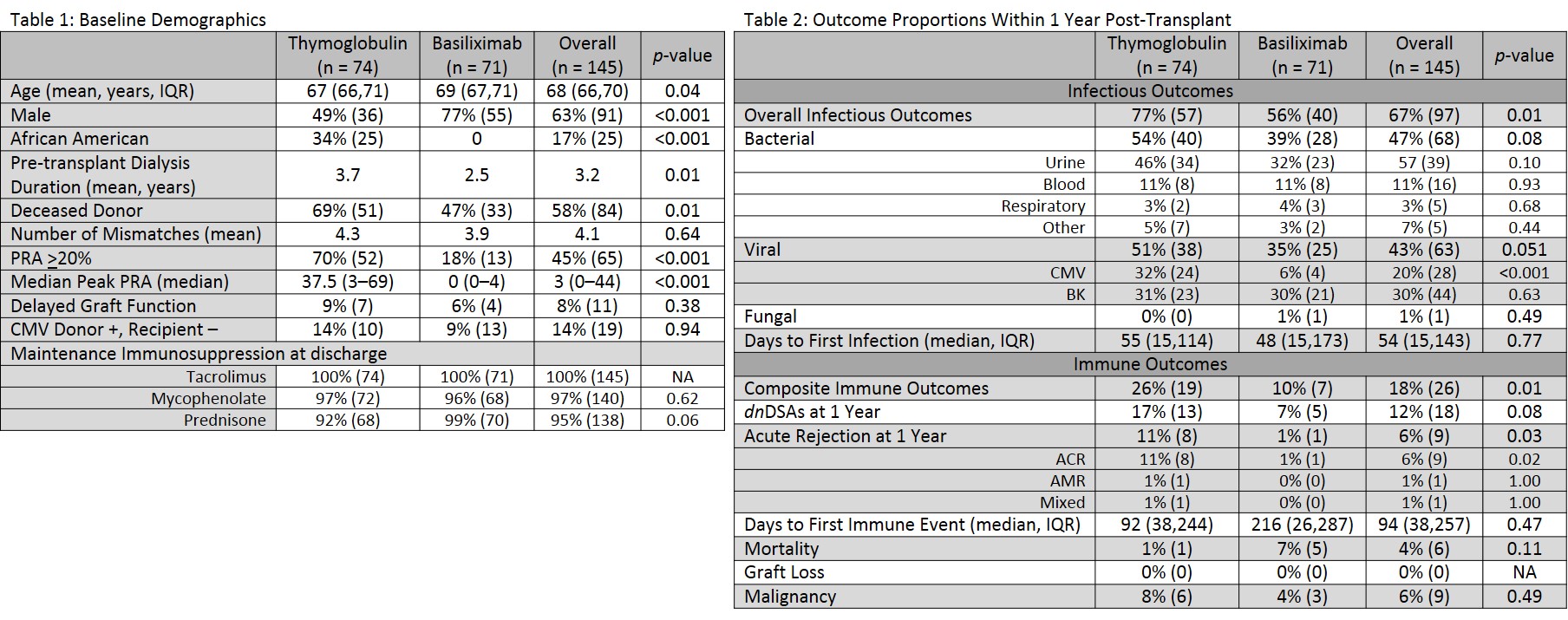Evaluation of Induction Immunosuppression in Elderly Kidney Transplant Recipients
Houston Methodist Hospital, Houston, TX
Meeting: 2019 American Transplant Congress
Abstract number: B207
Keywords: Elderly patients, Infection
Session Information
Session Name: Poster Session B: Kidney Immunosuppression: Induction Therapy
Session Type: Poster Session
Date: Sunday, June 2, 2019
Session Time: 6:00pm-7:00pm
 Presentation Time: 6:00pm-7:00pm
Presentation Time: 6:00pm-7:00pm
Location: Hall C & D
*Purpose: It is well recognized that elderly transplant recipients experience lower rates of acute rejection along with higher rates of infectious death compared to their younger counterparts. While less intensive immunosuppression may be preferable, currently there are no recommendations for depleting versus non-depleting induction strategies. We sought to compare infectious and immunologic outcomes between anti-thymocyte globulin (ATG) and basiliximab (IL2RA) induction in elderly kidney transplant recipients (KTRs).
*Methods: All KTRs >65 years from 2011 to 2017 receiving ATG or IL2RA induction were included. Per institution protocol, depleting induction was administered to patients with the following characteristics, irrespective of age: African American (AA), PRA ≥20%, and/or re-transplantation. Maintenance immunosuppression consisted of tacrolimus, mycophenolate, and prednisone. All patients underwent routine monitoring for BK, CMV, and de novo donor specific antibodies (dnDSAs) at months 1, 3, 6, 9, and 12 post-transplant. Infectious complications (bacterial, viral, and invasive fungal) and graft outcomes at 1 year were compared between KTRs who received induction with ATG (n=74) or IL2RA (n=71).
*Results: There were significantly more AA, deceased donors, and sensitized KTRs in the ATG group, reflecting the different criteria for induction agent (table 1). Consequently, development of dnDSAs (17% vs 7%, p=0.08) and rejection (11% vs 1%, p=0.03) occurred more frequently in the ATG group. These events occurred earlier, though not significantly, in the ATG group (92 vs 216 days). ATG KTRs experienced higher rates of overall infectious complications (77% vs 56%, p=0.01), owing predominately to increased rates of bacterial (54% vs 39%, p=0.08) and viral infections (51% vs 35%, p=0.05). Urinary tract infections and CMV in particular occurred at high rates among ATG patients (46% and 32%, respectively). Infections occurred early post-transplant in both ATG and IL2RA patients (55 and 48 days, respectively).
*Conclusions: Elderly KTRs receiving ATG are at an increased risk for infectious complications, which was largely attributable to high rates of urinary tract infections and CMV. Additional strategies aimed at mitigating these complications in elderly patients requiring ATG may be beneficial.
To cite this abstract in AMA style:
Pham C, Kuten S, Rogers A, Knight R, Nguyen DT, Graviss E, Gaber A. Evaluation of Induction Immunosuppression in Elderly Kidney Transplant Recipients [abstract]. Am J Transplant. 2019; 19 (suppl 3). https://atcmeetingabstracts.com/abstract/evaluation-of-induction-immunosuppression-in-elderly-kidney-transplant-recipients/. Accessed December 19, 2025.« Back to 2019 American Transplant Congress

